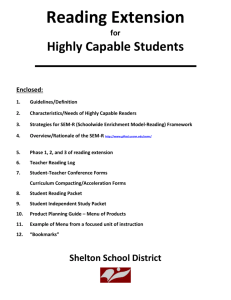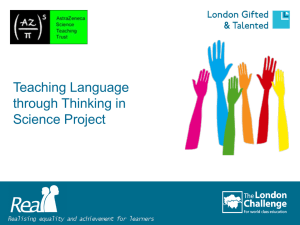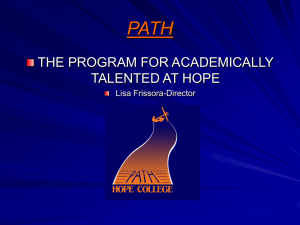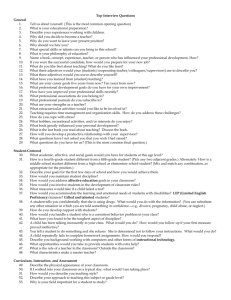What is the SEM-R? - Shelton School District
advertisement
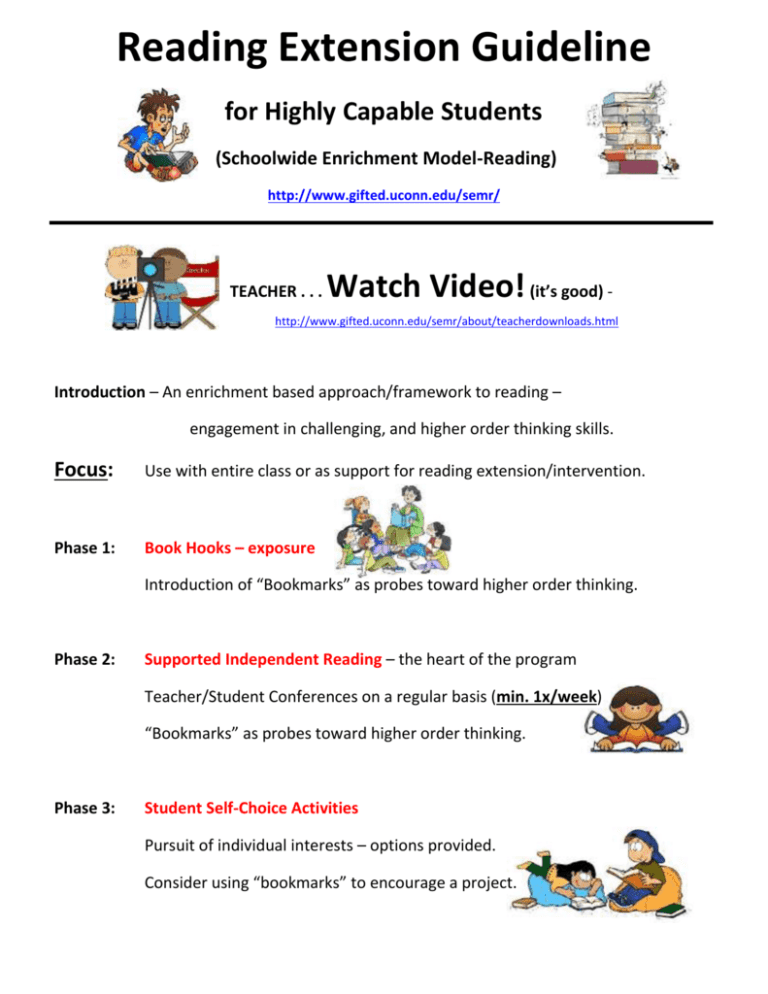
Reading Extension Guideline for Highly Capable Students (Schoolwide Enrichment Model-Reading) http://www.gifted.uconn.edu/semr/ TEACHER . . . Watch Video! (it’s good) - http://www.gifted.uconn.edu/semr/about/teacherdownloads.html Introduction – An enrichment based approach/framework to reading – engagement in challenging, and higher order thinking skills. Focus: Use with entire class or as support for reading extension/intervention. Phase 1: Book Hooks – exposure Introduction of “Bookmarks” as probes toward higher order thinking. Phase 2: Supported Independent Reading – the heart of the program Teacher/Student Conferences on a regular basis (min. 1x/week) “Bookmarks” as probes toward higher order thinking. Phase 3: Student Self-Choice Activities Pursuit of individual interests – options provided. Consider using “bookmarks” to encourage a project. What is the SEM-R? Students' first experiences with reading should be joyful, and as students grow, they should continue to enjoy and look forward to times spent reading and listening to books in the company of classmates. The more pleasurable these experiences, the more likely it is that students will want to read independently and develop the selfregulation necessary to remain lifelong readers. The Schoolwide Enrichment Model Reading Framework (SEM-R) is an enrichmentbased reading program designed to: Stimulate interest in and enjoyment of reading Promote and develop higher reading achievement Improve self-regulation and automaticity in reading Encourage students to select high-interest books that are slightly to moderately above their current reading levels Create independent, lifelong readers Research on the SEM-R has been supported through two federally funded Jacob K. Javits Gifted and Talented Students Education Act grants awarded by the U. S. Department of Education, Office of Elementary and Secondary Education. 2005-2009: Using the Schoolwide Enrichment Model Reading Framework (SEMR) to Increase Achievement, Fluency, and Enjoyment of Reading (Award # S206A040094) 2008-2011: The Schoolwide Enrichment-Model Reading (SEM-R) in the Middle Grades (Award # S206A080001) If you are interested in implementing the SEM-R in your school, please review the information provided in the About SEM-R section, beginning with the General Overview, and throughout this site. SEM-R and Talented Readers One important aspect of the SEM-R study involves our commitment to provide appropriate levels of challenge for talented readers. Little research has focused on challenging talented readers or using strategies that are an important part of gifted education (e.g., critical and creative problem solving and thinking, curriculum modification and differentiation, independent study, self-selected products) to encourage talented students to pursue challenging reading both in school and in their spare time (Jackson & Roller, 1993; Reis & Renzulli, 1989). Current research indicates that many talented readers have already mastered the majority of comprehension skills but are often required to study them again as part of the regular curriculum. The SEM-R was developed to increase reading challenge and enjoyment in all students, but one important goal of this approach is to challenge talented readers. Characteristics of Talented Readers As a group, talented readers are characterized by reading earlier than their peers, spending more time reading, reading a greater variety of literature, even into adulthood (Collins & Kortner, 1995; Halsted, 1990). reading at least two grade levels above their chronological grade placement, demonstrating advanced understanding of language, having an expansive vocabulary, perceiving relationships between and among characters, grasping complex ideas (Catron & Wingenbach, 1986; Dooley, 1993; Levande, 1999) having skills are advanced in relation to their peers, possibly not profiting from conventional instruction in reading (Levande, 1999) benefiting from diagnostically based instruction to ensure that their skills continually improve. Needs of Talented Readers Researchers who have examined practices for talented readers agree that regular reading instruction is often too easy for talented readers (Collins & Aiex, 1995; Dole & Adams, 1983; Reis & Renzulli, 1989; Shrenker, 1997) and that talented readers need different reading instruction. The appropriate match between a learner's abilities and the difficulty of the instructional work must be sought, and the optimal match should be instruction that is slightly above the learner's current level of functioning. As Chall and Conrad (1991) state, when the match is optimal, learning is enhanced; however, "if the match is not optimal [i.e., the match is below or above the child's level of understanding and knowledge], learning is less efficient and development may be halted" (p. 19). Talented readers have responded well to: high interest literature geared toward the students' reading levels rather than age (Renzulli, 1977), instruction geared toward the students' strengths (Renzulli & Reis, 1985; 1997) focus on developing higher level comprehension skills (Collins & Kortner, 1995) use of higher level questioning and opportunities to incorporate prior knowledge in reading experiences book discussions can also provide talented readers with the opportunity to interact with intellectual peers and to discuss their ideas in greater depth reading conferences facilitated by a teacher and focused on themes and ideas rather than on facts and plot summaries (Halsted, 1990). Unfortunately, using textbooks, basal readers, or even self-selected reading material that may be several years below students' reading level may create both halted development as well as motivational problems for talented readers. Some of your most talented readers may have learned to be lazy readers and may not react well to your attempts to challenge them to read at higher levels. The emphasis in school, however, must be on finding books that challenge and help talented readers to make continuous progress. The following strategies can be used to challenge talented readers in your reading classroom and are an integral part of SEM-R: Modification of the regular curriculum to eliminate skills and work that talented readers have already mastered Acceleration of content Substitution of regular reading material with more advanced trade books Use of technology and the web More complex assigned reading and writing Challenging group novels assigned for discussion to two or more talented readers Independent reading and writing choices Reading on-line from some of the advanced choices provided in the SEM-R intervention Independent study opportunities in an area of interest References Catron, R. M., & Wingenbach, N. (1986). Developing the gifted reader. Theory into Practice, 25(2), 134-140. Chall, J. S., & Conard, S. S. (1991). Should textbooks challenge students? The case for easier or harder textbooks. New York: Teachers College Press. Collins, N. D., & Aiex, N. K. (1995). Gifted readers and reading instruction . ERIC Clearinghouse on Reading, English and Communication Digest #101. Collins, N. D., & Kortner, A. (1995). Gifted readers and reading instruction. ERIC Digest. Bloomington, IN: ERIC Clearninghouse on Reading English and Communication. Accessed from http://www.ed.gov/databases/ERIC_Digests/ed389637.html on 11-20-01 . Dole, J. A., & Adams, P. J. (1983). Reading curriculum for gifted readers: A survey. Gifted Child Quarterly, 27, 64-72. Dooley, C. (1993). The challenge: Meeting the needs of gifted readers. The Reading Teacher, 46, 546-551. Halsted, J. W. (1990). Guiding the gifted reader. ERIC EC Digest E481. Accessed 1120-01 at http://kidsource.com/kidsource/content/guiding_gifted_reader.html . Jackson, N. E., & Roller, C. M. (1993). Reading with young children. (RM9302). Storrs, CT: The National Research Center on the Gifted and Talented, University of Connecticut. Levande, D. (1999). Gifted readers and reading instruction. CAG Communicator, 30(1), 19-20, 41-42. Levande, D. (1993). Identifying and serving the gifted reader. Reading Improvement, 30, 147-150. Reis, S. M., & Renzulli, J. S. (1989). Developing challenging programs for gifted readers. The Reading Instruction Journal, 32, 44-57. Renzulli, J. S. (1977). The enrichment triad model: A guide for developing defensible programs for the gifted and talented. Mansfield Center, CT: Creative Learning Press. Renzulli, J. S., & Reis, S. M. (1997). The schoolwide enrichment model: New directions for developing high-end learning. In N. Colangenlo, & G. A. Davis (Eds.) Handbook of gifted education (2nd ed., pp. 136-154). Boston: Allyn & Bacon. Renzulli, J. S., & Reis, S. M. (1985). The schoolwide enrichment model: A comprehensive plan for educational excellence.Mansfield Center, CT: Creative Learning Press. Shrenker, C. E. (1997). Meeting the needs of gifted students within whole group reading instruction. Ohio Reading Teacher, 31, 70-74. Overview This 14-minute video overview shows SEM-R working in real classrooms with real students and teachers. Getting Started (read this section at the end of each phase) Successful SEM-R implementation relies on: shared expectations and responsibility among the teacher and students. Here are a few tips on introducing SEM-R to your class and clarifying expectations: Take a class period to introduce each of the Phases to your students. Explain the purpose and procedures, and discuss expectations for behavior and strategies students may use for selfregulation. Remember to phrase expectations positively and emphasize the SEM-R focus on developing reading enjoyment! Take time to introduce the details of the student log and expectations for completing it. Show the sample pages, and consider showing an example of a poorly completed student log. Use Book Hook time to introduce and generate excitement about the classroom library. Include expectations for how to browse for new books, how to keep the library organized, etc. Draw attention to the posters as reminders for SEM-R procedures and expectations. Remember to use your teacher log to respond to the study expectations and to document your efforts. Phase 1: Book Hooks In Phase 1 the emphasis is on exposure. Students are exposed to high-quality and high-interest literature of various authors, genres, topics, and themes through teacher read-alouds. The goal of these book hooks is to entice students to read the book in much the same way as movie trailers entice people to watch the movie. The book hooks also provide exposure to new ideas, author's craft, and stimuli for discussion, which allow for higher levels of cognitive development. As part of these book hooks, teachers provide instruction in response to students' readiness and interest through modeling, questioning, and discussion focusing on demonstrating reading strategies, self-regulation skills, and the use of higher order questions such as those provided in SEM-R bookmarks. These discussions may also serve as starting points for making multiple connections to other literature, disciplines, personal experiences, and prior knowledge. While the emphasis in Phase 1 is on exposure, some book hooks may emphasize different objectives such as guiding students to think critically, apply reading strategies in their independent reading (Phase 2), or to stimulate interest for further inquiry (Phase 3). It is important to be considerate of the range of abilities and interests represented in the classroom and expose students to an appropriate balance of books. This includes easier books for lower readers and books that will challenge even the most advanced reader. Teachers can also look for creative ways to conduct book hooks, such as inviting special guest readers, using internet resources, or allowing students to dramatize a scene. Here are some brief tips to help you plan effective book hooks: Before you read – Take Three! 1. Exposure: Share why or how you chose the book (genre, author, topic, literary device?) 2. Critical Thinking: Choose a reading strategy or question to guide your discussion. 3. Connections: Consider links to other books, websites, art, experiences, activities, or projects. Leave them wanting to hear more (e.g., cliffhangers, unanswered questions or moral dilemmas) Model the use of reading strategies, advanced vocabulary, and supporting answers with text. Be Dramatic! Effective variation of intonation, speed, and volume can draw students in. Over the course of the year, the purpose and length of Book Hook sessions can vary. Early in the year, teachers may wish to focus more on generating enthusiasm toward reading and establishing classroom management and behavioral self-regulation procedures. Later in the year, teachers may emphasize stretching students with more challenging books and questioning, or focus on more specific learning objectives. Over the course of the year, connections can be made between the various books and concepts that have been introduced during Phase 1 to other content areas and student experiences. The length of the Book Hook session can vary depending on the objective for the day, but typically they should be between 10 and 15 minutes in duration. More ! Getting Started Focus on exposing students to a wide variety of genres and authors and generating enthusiasm for reading. Familiarize yourself with a few books from a wide variety of genres (including some non-fiction texts), authors, and reading levels. Make connections to students' interests and experiences when selecting books. Select one of your favorite books to use for a book hook. Share with students why and how you first selected it to read. Introduce students to the SEM-R bookmarks by incorporating some of the questions into your book hook. Explain to the students that they will also be able to use the bookmarks to ask themselves questions when they are reading. Have a central goal or main emphasis for each book hook. Preparing in advance will allow you to make careful links between specific titles, sections to read, and your objective for the book hook. Phase 2: Supported Independent Reading Phase 2, Supported Independent Reading, is the heart of the SEM-R program. During Phase 2, students read independently from self-selected, challenging books of high interest, while the teacher holds conferences with individual students. These conferences should last for about 5-7 minutes, and each student should have a conference approximately once a week. There are three major features of Phase 2: Students engage in challenging independent reading. Students should be reading self-selected books of interest that are at least 1 to 1.5 reading levels above their current reading level. The amount of time spent in Phase 2 should increase over time, based on student readiness and selfregulation, until students are reading independently about 35-45 minutes per day. Students use self-regulation strategies to monitor their reading and behavior. They may use bookmarks to ask themselves questions, sticky notes to mark places in the book they will later discuss in conferences, signaling strategies to let the teacher know if they need help, and their log to keep track of their reading from day to day. Teachers conduct individualized conferences to ask students questions and invite discussion; model and teach reading strategies; and assess student fluency, comprehension, and higher level skills. It is important for every student, including high-ability readers, to participate in the conferences on a regular basis. During an individual conference: A teacher asks the student to share information about the book, and then to read a short section aloud. The teacher engages the student in a discussion about the book, asking questions such as those on the bookmarks, questions that prompt specific reading strategies, or questions specific to the actual book. The teacher uses the student's oral reading and the discussion to determine whether the book is appropriately challenging, too easy, or too difficult for the student. At the end of a conference, the teacher gives the student specific strategies, goals, or questions to work on during independent reading over the next several days until that student's next conference. More ! Getting Started Supported Independent Reading (SIR) occurs within Phase 2. The majority of your instruction will occur during individual reading conferences in Phase 2. Key considerations: Establish clear expectations. (see handouts to be printed . . . “SIR poster” & “Self-Regulation Poster” http://www.gifted.uconn.edu/semr/about/teacherdownloads.html Keep conferences brief (approximately 5-7 minutes) Reinforce an environment conducive to conferences. In your conferences… Have authentic conversations around the books to develop students' overall enjoyment of reading. Check for appropriate book matches in terms of readability level as well as ideas and content. Provide specific instruction in reading skills and strategies based on students' needs. Ask questions to prompt students' thinking – use the bookmarks as a starting place. Phase 3: Student Self-Choice Activities Phase 3, Student Self-Choice Activities, is the portion of SEM-R where students have the opportunity to take the information and skills learned through Phases 1 and 2 and use them to pursue individual interests based on their learning style preferences. During Phase 3, teachers provide several options based on students' reading and individual interests for students to choose to complete in an effort to further expand and enrich their learning. Options provided might include online exploration of interests, author studies, development of expressive products such as writing, artwork, or performances, or shared conversations about books. Additional Phase 3 options include continuing to read independently, buddy reading with a friend, or listening to an audiobook. Over the course of the academic year, students are encouraged to move from teacher-directed opportunities to self-choice activities. Compile a List of Options – Completion is critical! May modify/NOT abandon! Try to provide at least 3-4 options for Phase 3. A few of the simplest options that you probably will want to incorporate frequently are as follows: (a) continue reading independently; (b) read with a buddy; (c) listen to an audio book; and (d) write about what you have been reading. When making an initial list of options for Phase 3 activities, you must keep in mind the variety of ability levels, areas of interest, and expression styles present within the students in your classroom. Having examples of completed projects (either that you have done or examples from the internet) can also help to guide both you and your students. Traditional options like written or oral book reports should not be completely discounted, but options like making a book trailer, creating a Facebook page for a character, or writing scenes in script form give students an alternative option to showcase their knowledge. Long-term creative projects are an effective option for Phase 3 and in many instances hold longterm benefits in students' self-efficacy and attitude. However, ensure that students have a choice either in their Phase 3 activities every session or at least for some sessions as a break from a longterm project. Consider establishing "interest groups" whereby students with shared interests can work on projects related to that area of interest. Understanding Readiness Not all students will be ready to begin Phase 3 at the same time. For instance, some students will need more support with basic reading skills, while your more advanced students might be ready to begin independent projects at the beginning of the year. Logistics Initially, you should be working closely with students to monitor their project selections and their progress. Over time, students should begin taking control of their projects as the role of facilitator shifts from you to them. Many teachers find it easier (and more natural) to allot entire class periods to working on Phase 3. This gives students who are working on projects a sizable amount of time to work, but if other students are not ready for Phase 3, they can continue their regular reading schedule. More ! Getting Started Compile a list of options. Start SMALL and dream big. Consider student abilities, interests, and expression styles Show examples of completed products, performances, or services. Consider traditional and nontraditional choices. Start with fewer options and expand the menu over time. Realize that not all students will be ready for Phase 3 at the same time. Look for opportunities for students to serve others, address real-world problems, and/or present to authentic audiences other than the teacher. CONFERENCE PLANNING Area(s) of Focus for the Cycle: Relevant Bookmarks: “Back-up” for Books that Don’t Fit: Special Areas of Focus for Individual Students: Conference Information Date: Length: Notes: Book: Did the student read aloud? Y / N Conference Focus: Is this for book appropriately challenging? Y / N Focus Next Time: Conference Rubric for Teachers In general, how did student perform relative to your expectations this week? (circle one) below expectations met expectations exceeded expectations Book Match Is this book appropriately challenging? Yes / No Reader & Task Factors Qualitative Factors Quantitative Factors e.g., Interest, Interaction, Questioning Complexity, Language, Structure, Knowledge Demands Matched: Yes / No Matched: Yes / No Other Merit (e.g., Classic, Topic, Personal Relevance): Student SEM-R Goals for Next Week e.g., Lexile Stretch Text band, reading rate Matched: Yes / No Key Expectations for Student Next Week: Behavior/Engagement Reading Progress Common Core Reading Standards Key Ideas and Details 1. Read closely to determine what the text says explicitly and to make logical inferences from it; cite specific textual evidence when writing or speaking to support conclusions drawn from the text 2. Determine central ideas or themes of a text and analyze their development; summarize the key supporting details and ideas. 3. Analyze how and why individuals, events, and ideas develop and interact over the course of a text. Craft and Structure 4. Interpret words and phrases as they are used in a text, including determining technical, connotative, and figurative meanings, and analyze how specific word choices shape meaning or tone. 5. Analyze the structure of texts, including how specific sentences, paragraphs, and larger portions of the text (e.g., a section, chapter, scene, or stanza) relate to each other and the whole. 6. Assess how point of view or purpose shapes the content and style of a text. Integration of Knowledge and Ideas 7. Integrate and evaluate content presented in diverse media and formats, including visually and quantitatively, as well as in words. 8. Delineate and evaluate the argument and specific claims in a text, including the validity of the reasoning as well as the relevance and sufficiency of the evidence. 9. Analyze how two or more texts address similar themes or topics in order to build knowledge or to compare the approaches the authors take. Range of Reading and Level of Text Complexity 10. Read and comprehend complex literary and informational texts independently and proficiently. Student: _____________________________________________ More ! Written Response Rubric 3=Proficient 4=Advanced 1= Emerging 2=Basic 5=Superior On topic. Responds to the question. Well organized. Avoids redundancy. Articulate. Strong word choice. Clear and concise. Elaborate: Supported by evidence from text or other sources as necessary. Other Bonus: Going above and beyond (e.g., thoughtful / insightful response) Total Score


